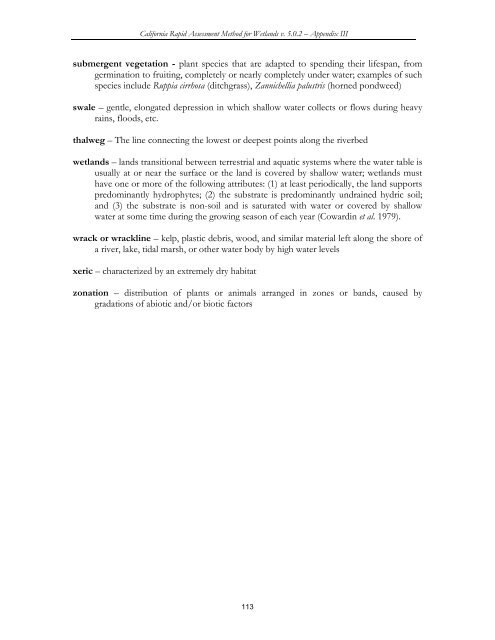(CRAM) For Wetlands User's Manual Version 5.0.2
(CRAM) For Wetlands User's Manual Version 5.0.2
(CRAM) For Wetlands User's Manual Version 5.0.2
Create successful ePaper yourself
Turn your PDF publications into a flip-book with our unique Google optimized e-Paper software.
California Rapid Assessment Method for <strong>Wetlands</strong> v. <strong>5.0.2</strong> – Appendix III<br />
submergent vegetation - plant species that are adapted to spending their lifespan, from<br />
germination to fruiting, completely or nearly completely under water; examples of such<br />
species include Ruppia cirrhosa (ditchgrass), Zannichellia palustris (horned pondweed)<br />
swale – gentle, elongated depression in which shallow water collects or flows during heavy<br />
rains, floods, etc.<br />
thalweg – The line connecting the lowest or deepest points along the riverbed<br />
wetlands – lands transitional between terrestrial and aquatic systems where the water table is<br />
usually at or near the surface or the land is covered by shallow water; wetlands must<br />
have one or more of the following attributes: (1) at least periodically, the land supports<br />
predominantly hydrophytes; (2) the substrate is predominantly undrained hydric soil;<br />
and (3) the substrate is non-soil and is saturated with water or covered by shallow<br />
water at some time during the growing season of each year (Cowardin et al. 1979).<br />
wrack or wrackline – kelp, plastic debris, wood, and similar material left along the shore of<br />
a river, lake, tidal marsh, or other water body by high water levels<br />
xeric – characterized by an extremely dry habitat<br />
zonation – distribution of plants or animals arranged in zones or bands, caused by<br />
gradations of abiotic and/or biotic factors<br />
113















